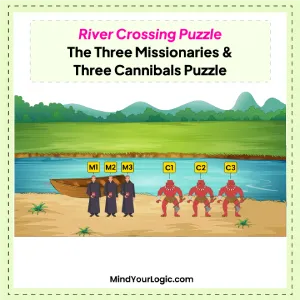River Crossing puzzle: How Three Thieves Safely Transport Their Stolen Gold | MindYourLogic River Crossing Puzzle
Three thieves need to cross a river, each with a bag containing a specific amount of stolen gold coins. Thief A has 1000 coins, Thief B has 700 coins, and Thief C has 300 coins. The problem lies in the fact that the boat available to them can only carry two objects at a time, meaning either two thieves can cross the river together or one thief with his bag of coins. The challenge is that if any thief is left alone with more coins than he personally possesses, he will be tempted to run off with the extra gold. This rule also applies if two thieves are left together with a combined amount of gold greater than their own.

To ensure that all three thieves cross the river without anyone absconding with the gold, a specific sequence of actions must be followed. Here’s the step-by-step strategy they can use:
Step 1: Thief B starts by crossing the river with his bag of 700 coins. Upon reaching the other side, he leaves his bag there and returns to the original side alone.
Step 2: Thief A then takes Thief C's bag of 300 coins and crosses the river. After leaving the bag on the other side, Thief A returns empty-handed to the original side.
Step 3: Next, Thief B and Thief C cross the river together, but Thief C returns with his bag of 300 coins to the original side.

Step 4: Thief A then crosses the river with his own bag of 1000 coins, leaving Thief B on the other side. Thief B then returns to the original side with his 700-coin bag.
Step 5: Thief B and Thief C cross the river again, leaving Thief A on the original side. This time, Thief A takes the 300-coin bag and crosses the river, leaving the bag on the other side.
Step 6: Finally, Thief B crosses the river one last time to retrieve his 700-coin bag.
By carefully following this sequence, all three thieves successfully cross the river along with their respective gold without violating the conditions that would cause one to run off with the others' loot.
Conclusion: The key to solving this puzzle is ensuring that at no point is any thief left with more coins than he owns or in a situation where he could steal from another. This well-coordinated strategy not only highlights the importance of planning and cooperation but also shows how seemingly impossible problems can be solved with logical thinking and careful execution. In real-world scenarios, similar logic can be applied to problems requiring resource management and trust-building within a group.







